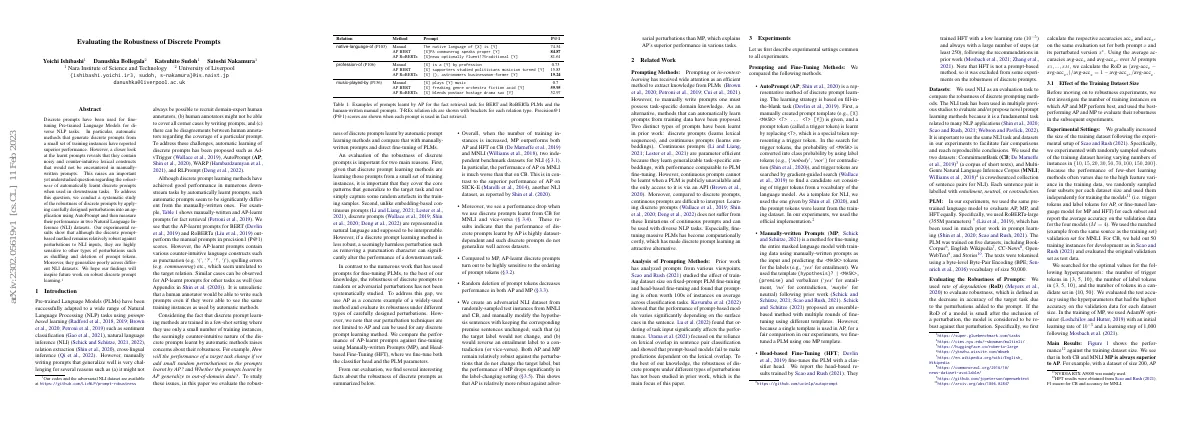Link to paper
The full paper is available here.
You can also find the paper on PapersWithCode here.
Abstract
- Discrete prompts have been used to fine-tune Pre-trained Language Models.
- Automatic methods can generate discrete prompts from a small set of training instances.
- Automatically learnt discrete prompts contain noisy and counter-intuitive lexical constructs.
- Study of robustness of discrete prompts by applying perturbations to an application using AutoPrompt.
- Discrete prompt-based method remains relatively robust against NLI input perturbations.
- Highly sensitive to other types of perturbations such as shuffling and deletion of prompt tokens.
- Generalize poorly across different NLI datasets.
Paper Content
Introduction
- Pre-trained Language Models (PLMs) have been used for a range of Natural Language Processing (NLP) tasks
- Manual writing of prompts is challenging
- Automatic learning of discrete prompts has been proposed
- Table 1 shows manually-written and AP-learnt prompts for fact retrieval
- AP-learnt prompts outperform manual prompts in precision scores
- AP-learnt prompts contain counter-intuitive language constructs
- Automatic methods use a small number of training instances
- Evaluation of robustness of discrete prompts is important
- Discrete prompts are represented in natural language and supposed to be interpretable
- Evaluation of robustness of discrete prompts to random or adversarial perturbations has not been studied
- AP is used as an example of a widely-used method
- MP outperforms both AP and HFT on CB and MNLI
- Performance of AP is highly dataset-dependent
- AP and MP are sensitive to the ordering of prompt tokens
- Random deletion of prompt tokens decreases performance in both AP and MP
- AP is relatively more robust against adversarial perturbations than MP
Related work
- Prompting or in-context learning is an efficient method to extract knowledge from PLMs
- Two types of prompts can be learnt: discrete and continuous
- Continuous prompts are parameter efficient but cannot be learnt when a PLM is not publicly available
- Discrete prompts can be used with diverse NLP tasks and are an attractive alternative to finetuning massive PLMs
- Prior work has analyzed prompts from various viewpoints
Experiments
- AutoPrompt (AP) is a method of discrete prompt learning based on fill-in-the-blank tasks
- Manually-written Prompts (MP) is a method for fine-tuning the entire masked language model with training data using manually-written prompts
- Head-based Fine-Tuning (HFT) fine-tunes the PLM with a classifier head
- RoBERTa-large (355M parameters) was used as the pretrained language model
- Rate of degradation (RoD) was used to evaluate robustness
- AP, MP, and HFT were evaluated on NLI
- MP was always superior to AP
- Performance of AP is highly dataset dependent
- HFT is superior to AP in some datasets
- Accuracy of MNLI was low on AP
- Table 2 shows the average accuracy of models trained on 200 instances that performed well in both CB and MNLI
Token reordering
- AP prompts have no obvious ordering among their tokens
- Experiment conducted to measure effect of token order in discrete prompt
- Accuracy of AP drops significantly when prompt tokens are randomly reordered
- MP accuracy drops only slightly when prompt tokens are randomly reordered
- AP prompts rely heavily on token order
- Accuracy of AP drops as perturbation noise (measured by edit distance) increases
Token deletion
- AP performs better than MP
- It is difficult to determine the importance of prompt tokens
- An experiment was conducted to delete one or more prompt tokens from a given discrete prompt
- Results show that accuracy of both AP and MP drops when a single token is deleted
- Performance of both AP and MP degrades when more tokens are deleted
- Accuracy drop in CB is very small for MP even when all prompt tokens are deleted
Cross-dataset evaluation
- Discrete prompt learning methods learn prompts from a small set of training instances.
- Cross-dataset evaluation is used to study the transferability of the learnt discrete prompts.
- Results show that AP-based prompts do not generalize well across datasets.
Adversarial perturbations
- Adversarial perturbations can be used to probe the robustness of models
- Previous studies have shown models can be fooled by perturbated test instances
- Two annotators manually edited hypothesis sentences with two types of perturbations
- Perturbations without label changes resulted in small RoD values
- Perturbations with label changes resulted in significant drops in accuracy for both AP and MP
Conclusion
- Discrete prompts remain relatively robust against token deletion
- Highly sensitive to token shuffling
- AP more robust than MP for perturbations with label changes
- Generalize poorly across different datasets annotated for NLI
- Possible limitations include not investigating other methods, using RoBERTa-large, focusing on NLI, and English datasets
- Performance gap between MP/HFT and AP could affect accuracies
- Aim is to analyze robustness of discrete prompts
- Adversarial dataset came from existing datasets of CB and MNLI with no ethical concerns
- RoBERTa known to have gender biases
